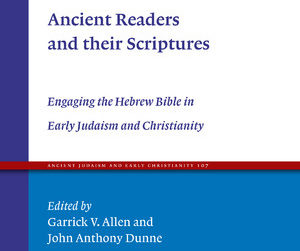I am thrilled to say that our new book is finally out, Ancient Readers and Their Scriptures: Engaging the Hebrew Bible in Early Judaism and Christianity. The book was published by Brill just a few weeks ago and will be on display just in time for the annual meeting of the Society of Biblical Literature beginning this weekend in Denver, Colorado. The book appears as volume 107 in the Ancient Judaism and Early Christianity series, and we couldn’t be more excited!
The book is an edited volume containing essays that were originally presented at a conference that I co-organized with the co-editor of the volume, Garrick V. Allen. The conference was part of the series of conferences at the University of St Andrews, known as the St Andrews Symposium, which was started by my friend Dan Batovici. Dan ran the first two instantiations of the conference by himself, and then I came on for the third one on “Sacred Texts in Their Socio-Political Contexts,” which was later collected into a volume edited by Dan and myself published in the WUNT II volume by Mohr Siebeck, Reactions to Empire. Our conference on “Ancient Reading” was the fourth version of the conference, and I’m excited that it’s still ongoing; this past summer I was able to head back to St Andrews for the conference on the “Atonement.” The conference for the present volume on ancient reading actually took place in the summer of 2014, so that means that we have been working on getting this volume together for over four years! It’s been a fun process and we’re delighted that it’s finally available. In fact, here’s a blog post that I created on January 28, 2014 with the call for papers and early bird registration announcement for our conference!
Our book is finally out and we’re excited to hear what people think.
Here’s the short blurb indicating what the book is about. Ancient Readers and Their Scriptures
explores the various ways that ancient Jewish and Christian writers engaged with and interpreted the Hebrew Bible in antiquity, focusing on physical mechanics of rewriting and reuse, modes of allusion and quotation, texts and text forms, text collecting, and the development of interpretative traditions. Contributions examine the use of the Hebrew Bible and its early versions in a variety of ancient corpora, including the Septuagint, Dead Sea Scrolls, New Testament, and Rabbinic works, analysing the vast array of textual permutations that define ancient engagement with Jewish scripture. This volume argues that the processes of reading and cognition, influenced by the physical and intellectual contexts of interpretation, are central aspects of ancient biblical interpretation that are underappreciated in current scholarship.
Here’s the Brill link.
Here’s the Amazon link.
If you’re interested in the use of the Hebrew Bible (in its various versions) in the New Testament, intertextuality, scribal culture, reading strategies, etc, be sure to check out our new book!





Leave a Reply
Your email is safe with us.